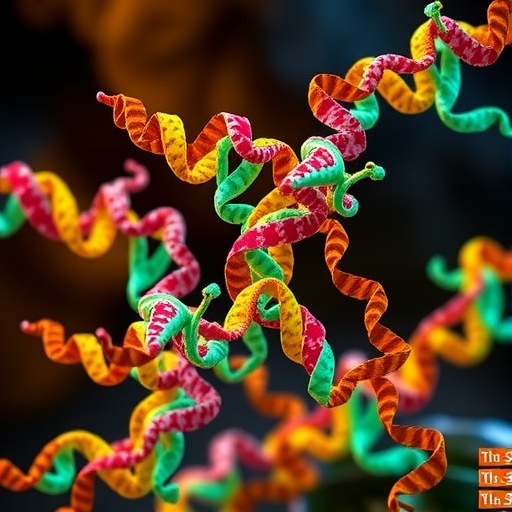In the ever-evolving landscape of molecular biology, understanding the intricate mechanisms that govern chromatin architecture remains a frontier of immense interest. A groundbreaking study led by Malik, Deshmukh, Bilokapic, and colleagues, published in Cell Research in 2025, has shed unprecedented light on the molecular choreography executed by the human Snf2-type ATPase SNF2H during chromatin remodeling. This discovery not only illuminates critical aspects of genome regulation but also opens new avenues for therapeutic intervention in diseases where chromatin dynamics go awry.
Chromatin remodeling is a fundamental process by which eukaryotic cells alter the structure of chromatin — the complex of DNA and histone proteins — thereby modulating access to the genetic code. Central to this process are ATP-driven molecular machines, including the Snf2 family of ATPases. Among them, SNF2H, a member of the ISWI (Imitation Switch) subfamily, has emerged as a pivotal regulator, yet the precise mechanisms by which it refines chromatin structure have remained largely mysterious until now.
The study meticulously dissects how SNF2H harnesses the energy derived from ATP hydrolysis to slide nucleosomes along DNA. This repositioning is not a random event; it requires highly coordinated structural transformations both within SNF2H and the nucleosome substrate. Cryo-electron microscopy combined with biochemical assays unveiled that SNF2H interacts with the nucleosome at distinct interfaces, translating ATP hydrolysis into mechanical force that repositions DNA around histone octamers.
One of the remarkable findings highlighted in the research is the conformational plasticity of SNF2H, which adjusts its structural domains in response to nucleosome engagement. This flexibility underscores a dynamic allosteric regulation mechanism that ensures efficient chromatin remodeling activity. The authors reveal that the interaction between SNF2H’s ATPase domain and the nucleosome’s DNA strongly influences the enzyme’s catalytic cycle, positioning SNF2H as a finely tuned molecular motor.
Further emphasizing the complexity, the team discovered that SNF2H-mediated sliding is tightly coupled with histone-DNA contacts. As SNF2H translocates DNA, it transiently destabilizes nucleosome wrapping, facilitating nucleosome mobilization without disassembly. This mechanism is crucial to maintain chromatin integrity while enabling access to specific genomic regions required for transcription, replication, and repair.
Intriguingly, the study also explores how SNF2H’s remodeling function is context-dependent, modulated by the presence of auxiliary protein factors and post-translational histone modifications. These modulators act as molecular signals that fine-tune SNF2H activity, ensuring precise remodeling patterns across different chromatin landscapes and cellular states. Such insights help explain how chromatin remodelers achieve selectivity amidst the complex nuclear environment.
At the molecular level, Malik and colleagues identified key residues within SNF2H’s ATPase domain that act as sensors for nucleotide binding and hydrolysis states. Mutagenesis experiments showed that altering these residues impairs the enzyme’s ability to couple ATP turnover with DNA translocation, confirming their essential role in chromatin remodeling. These findings pave the way for the development of small molecules targeting SNF2H activity, with potential implications for epigenetic therapies.
Another critical aspect revealed by the research is SNF2H’s ability to discriminate between different nucleosome substrates. The enzyme demonstrates a preference for nucleosomes with specific histone variant compositions and DNA sequences, reflecting a sophisticated recognition mechanism. This substrate specificity contributes to the precise spatial and temporal control of chromatin remodeling during cellular processes such as differentiation and stress responses.
Beyond fundamental biology, the study has profound implications for understanding disease mechanisms. Aberrant chromatin remodeling is implicated in cancers, neurodevelopmental disorders, and aging-related pathologies. By elucidating SNF2H’s remodeling mechanism, the current research offers a molecular framework to interpret how mutations or dysregulated expression of chromatin remodelers contribute to disease etiology.
The authors also discuss potential intersections between SNF2H activity and DNA damage repair pathways. Chromatin remodeling is a prerequisite for efficient repair by granting repair machinery access to damaged DNA. Understanding how SNF2H coordinates chromatin dynamics in response to DNA lesions could inform strategies to enhance genome stability in therapeutic contexts.
Methodologically, the study exemplifies the power of integrative structural biology, combining high-resolution cryo-EM, single-molecule biophysics, and in vitro reconstitution systems. This multi-pronged approach allowed the team to capture transient remodeling intermediates and elucidate the stepwise mechanism by which SNF2H mobilizes nucleosomes, setting a new standard for studying ATP-dependent chromatin remodelers.
The findings reported by Malik, Deshmukh, Bilokapic, and co-workers represent a landmark achievement in chromatin biology, offering a detailed molecular blueprint of SNF2H’s function. As chromatin remodeling continues to be recognized as a central determinant of gene regulation, this comprehensive mechanistic insight will inspire future research exploring how modulating remodeler activity can be harnessed for therapeutic benefit.
In conclusion, this seminal work not only demystifies the operational principles of a major chromatin remodeling ATPase but also underscores the intricate interplay between enzymatic motors and chromatin substrates. It sets the stage for innovative research at the intersection of structural biology, epigenetics, and disease, highlighting the transformative potential of targeting chromatin dynamics in medicine.
Subject of Research: Mechanisms of chromatin remodeling by the human Snf2-type ATPase SNF2H
Article Title: Mechanisms of chromatin remodeling by the human Snf2-type ATPase SNF2H
Article References:
Malik, D., Deshmukh, A., Bilokapic, S. et al. Mechanisms of chromatin remodeling by the human Snf2-type ATPase SNF2H. Cell Res (2025). https://doi.org/10.1038/s41422-025-01103-w
Image Credits: AI Generated




